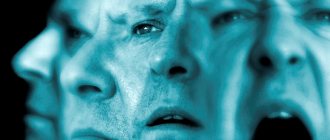TREATMENT FOR DELUSION AVAILABLE AT: BRANCHES:
Treatment of delirium in the Primorsky region
Address: St. Petersburg , Primorsky district, st. Repisheva, 13
Treatment of delirium in the Petrograd region
Address: St. Petersburg , Petrogradsky district, st. Lenina, 5
Treatment of delirium in the Krasnogvardeysky district
Address: St. Petersburg , Krasnogvardeisky district, Novocherkassky pr., 33 building 3
Treatment of delirium in Vsevolozhsk
Address: Vsevolozhsk , Oktyabrsky Prospekt, 96 A
From a medical point of view, a distorted perception of reality is a symptom of many psychotic illnesses associated with disorders of the brain. This is a thinking disorder in which a person holds beliefs that do not correspond to reality and makes erroneous conclusions that cannot be corrected, since they seem logical and the only true one. These “three pillars” (inconsistency with reality and at the same time a person’s conviction in the logic and correctness of his own conclusions) were defined back in 1913, when a detailed study of this pathology began.
Often, illusory perception is detailed and has a system of personal internal evidence for a person. So, a person can “recharge” from the network if he considers himself a battery, and will really feel a surge of energy or will be able to do for a long time without products that he considers dangerous for himself. Treatment of a delusional disorder (for example, it can be a common delusion of jealousy) always involves overcoming a person’s internal resistance.
Delusions Signs and symptoms of mental disorder
Delusion is a persistent belief that arose on pathological grounds, is not susceptible to the influence of reasonable arguments or evidence to the contrary and is not an instilled opinion that could be acquired by a person as a result of appropriate upbringing, education received, the influence of traditions and cultural environment.
This definition is intended to distinguish delusions indicative of mental disorder from other types of persistent beliefs that may occur in healthy people. Usually (but not always) a delusion is a false belief. The criterion for delusion is that it is firmly based on an inadequate basis, that is, this belief is not the result of normal processes of logical thinking. The strength of conviction is such that it cannot be shaken even by seemingly irrefutable evidence to the contrary. For example, a patient with a delusional idea that his pursuers are hiding in the neighboring house will not give up this opinion even when he sees with his own eyes that the house is empty; against all odds he will retain his belief, assuming, for example, that the pursuers left the building before it was examined. It should be noted, however, that normal people with ideas of a non-delusional nature sometimes remain just as deaf to the arguments of reason; an example of this is the common beliefs of people with common religious or ethnic roots. Thus, a person brought up in the traditions of belief in spiritualism is unlikely to change his beliefs under the influence of strong evidence to the contrary, convincing to anyone whose worldview is not associated with such beliefs.
Although usually, as already noted, a Delusional Idea is a false belief, under exceptional circumstances it may turn out to be true or subsequently become so. A classic example is pathological jealousy (see p. 243). A man may develop delusions of jealousy towards his wife in the absence of any substantiated evidence of her infidelity. Even if the wife is truly unfaithful at the time, the belief is still delusional unless there is a reasonable basis for it. The point to be emphasized is that it is not the falsity of a belief that determines its delusional character, but the nature of the mental processes that led to that belief. Meanwhile, it is known that in clinical practice the stumbling block is the tendency to consider a belief false just because it seems strange, instead of checking the facts or finding out how the patient came to this opinion. For example, seemingly incredible stories of being stalked by neighbors or of a spouse trying to poison a patient sometimes have a basis in reality, and in the end it can be established that the corresponding conclusions are the result of normal processes of logical thinking and that they are in fact fair.
The definition of delusion emphasizes that a characteristic feature of a delusional idea is its stability. However, the belief may not be so strong before (or after) the delusion is fully formed. Sometimes delusional ideas appear in a person’s mind already fully formed, and the patient is absolutely convinced of their truth from the very beginning, but in other cases they develop more gradually. Similarly, while recovering, the patient may go through a stage of increasing doubt about his delusional ideas before finally rejecting them as false. The term Partial Delusion is sometimes used to refer to this phenomenon, as in the Status Survey (see p. 13). It is advisable to use this term only if it is known that either partial delirium was preceded by complete delirium, or it subsequently developed into complete delirium (retrospective approach). Partial delusions can be detected in the early stages of schizophrenia. However, when identifying this symptom, you should not draw certain conclusions regarding the diagnosis only on this basis. A thorough examination should be performed to look for other signs of mental illness. Despite the fact that the patient may be completely confident in the truth of the delusional idea, this belief does not necessarily affect all his feelings and actions. This separation of belief from feelings and actions, known as Dual Orientation, is most common in chronic schizophrenics. Such a patient, for example, believes that he is a member of the royal family, but at the same time lives quietly in a home for mental patients discharged from the hospital. It is necessary to distinguish delusions from Overvalued ideas, which were first described by Wernicke (1900). An overvalued idea is an isolated, all-consuming belief of a different nature than delusions and obsessions; it sometimes dominates the patient’s life for many years and can influence his actions. The roots of the belief that occupies the patient's thoughts can be understood by analyzing the details of his life. For example, a person whose mother and sister died of cancer one after the other may succumb to the belief that cancer is contagious. Although distinguishing between a delusion and an overvalued idea is not always easy, in practice it rarely leads to serious problems, since the diagnosis of mental illness depends on more than the presence or absence of any one symptom. (For more information on high value ideas, see McKenna 1984.)
There are many types of delusions, which will be described below. The table will help the reader in the next section. 1.3.
Primary, or autochthonous, delusion is a delusion that arises suddenly with full conviction of the truth of its content, but without any mental events leading to it. For example, a patient with schizophrenia may suddenly have a complete conviction that his gender is changing, although he had never thought about anything like that before and was not preceded by any ideas or events that could push him to such a conclusion in any way. in a logically explicable way. A belief suddenly arises in the mind, fully formed and in an absolutely convincing form. Presumably it represents the direct expression of the pathological process that is the cause of mental illness - the primary symptom. Not all primary delusions begin with an idea; delusional mood (see p. 21) or delusional perception (see p. 21) can also arise suddenly and without any antecedent events to explain them. Of course, it is difficult for the patient to remember the exact sequence of such unusual, often painful mental phenomena, and therefore it is not always possible to establish with complete certainty which of them is primary. Inexperienced doctors usually make the diagnosis of primary delirium too easily, without paying due attention to the study of previous events. Primary delusions are of great importance in the diagnosis of schizophrenia, and it is very important not to register it until there is complete confidence in its presence. Secondary delusions can be regarded as a derivative of any previous pathological experience. Several types of experiences can cause a similar effect, in particular hallucinations (for example, a patient who hears voices, on this basis comes to the belief that he is being persecuted), mood (a person in deep depression may believe that people consider him insignificant); In some cases, the delusion develops as a consequence of a previous delusional idea: for example, a person with delusions of impoverishment may fear that losing money will send him to prison because he will not be able to pay his debts. It seems that in some cases secondary delusions perform an integrating function, making the initial sensations more understandable to the patient, as in the first example given. Sometimes, however, it seems to have the opposite effect, increasing the feeling of persecution or failure, as in the third example. The accumulation of secondary delusional ideas can result in the formation of an intricate delusional system in which each idea can be regarded as arising from the previous one. When a complex set of interrelated ideas of this kind is formed, it is sometimes defined as systematic delusion.
Under certain circumstances, induced delirium occurs. As a rule, others consider the patient’s delusional ideas to be false and argue with him, trying to correct them. But it happens that a person who lives with a patient begins to share his delusional beliefs. This condition is known as induced delirium, or Folic A Deux. While the couple remains together, the other person's delusional beliefs are as strong as those of the partner, but they tend to be quickly reduced when the couple separates.
Table 1.3. Description of delirium
1. By persistence (degree of conviction): complete partial 2. By the nature of occurrence: primary secondary 3. Other delusional states: delusional mood delusional perception retrospective delusion (delusional memory) 4. By content: persecutory (paranoid) relations of grandeur (expansive) guilt and low value nihilistic hypochondriacal religious jealousy sexual or love delusions of control
delusion regarding the possession of one's own thoughts delusion of transmission (broadcasting) of thoughts
(In the domestic tradition, these three symptoms are considered as an ideational component of the syndrome of mental automatism) 5. According to other signs: induced delirium
Typically, when a patient first develops delusions, he also has a certain emotional reaction and perceives his surroundings in a new way. For example, a person who believes that a group of people are going to kill him is likely to feel fear. Naturally, in such a state, he can interpret the reflection of the car seen in the rear-view mirror as evidence that he is being followed.
In most cases, delirium occurs first, and then the remaining components are added. Sometimes the reverse order is observed: first there is a change in mood - often this is expressed in the appearance of a feeling of anxiety, accompanied by a bad feeling (it seems as if something terrible is about to happen) - and then delirium follows. In German, this change in mood is called WaJinstimmung, which is usually translated as Delusional Mood. The latter term cannot be considered satisfactory, because in fact we are talking about the mood from which delirium arises. In some cases, the change that has occurred is manifested in the fact that familiar objects of perception suddenly, without any reason, appear to the patient as if bearing a new meaning. For example, an unusual arrangement of objects on a colleague's desk may be interpreted as a sign that the patient has been chosen by God for some special mission. The described phenomenon is called Delusional perception; This term is also unfortunate because it is not the perception that is abnormal, but the false meaning given to the normal object of perception.
Despite the fact that both terms are far from meeting the requirements, there is no generally accepted alternative to them, so they have to be resorted to if it is necessary to somehow designate a certain state. However, it is usually better to simply describe what the patient is experiencing and record the order in which changes in ideas, affect, and interpretation of sensations occurred. With the corresponding disorder, the patient sees a familiar person, but believes that he has been replaced by an impostor who is an exact copy of the real one. Sometimes this symptom is designated by the French term Villusion De Sosies (illusion of a double), but this, of course, is nonsense, not an illusion. The symptom can persist so long and persistently that even a syndrome has been described— Capgras Syndrome —in which this symptom is the main characteristic feature (see p. 247). There is also an erroneous interpretation of the experience that is opposite in nature, when the patient recognizes the presence of different appearances in several people, but believes that behind all these faces is the same disguised pursuer. This pathology is called Breda Fregoli. A more detailed description of it is given further on p. 247.
Some delusions relate to past rather than present events; in this case they talk about delusional memories (retrospective delusions). For example, a patient who is convinced of a conspiracy to poison him may attribute new meaning to the memory of an episode in which he vomited after eating long before the delusional system emerged. This experience must be distinguished from the exact memory of a delusional idea formed at that time. The term "delusional memory" is unsatisfactory because it is not the memory that is delusional, but its interpretation.
In clinical practice, delusions are grouped according to their main themes. This grouping is useful because there is some correspondence between certain themes and the main forms of mental illness. However, it is important to remember that there are many exceptions that do not fit into the generalized associations mentioned below.
Delusions of persecution are often called Paranoid, although this definition has, strictly speaking, a broader meaning. The term “paranoid” appears in ancient Greek texts to mean “insanity,” and Hippocrates used it to describe feverish delirium. Much later, this term began to be applied to delusional ideas of grandeur, jealousy, persecution, as well as erotic and religious ones. The definition of “paranoid” in its broad sense is still used today in application to symptoms, syndromes and personality types, while remaining useful (see Chapter 10). Persecutory delusions are usually directed at an individual or at entire organizations that the patient believes are trying to harm him, tarnish his reputation, drive him crazy, or poison him. Such ideas, although typical, do not play a significant role in making a diagnosis, since they are observed in organic conditions, schizophrenia and severe affective disorders. However, the patient’s attitude towards delusions can have diagnostic significance: it is characteristic that in severe depressive disorder the patient tends to accept the alleged activities of the persecutors as justified, due to his own guilt and worthlessness, while the schizophrenic, as a rule, actively resists, protests, and expresses his anger. In evaluating such ideas, it is important to remember that even seemingly improbable accounts of persecution are sometimes supported by facts, and that in certain cultural environments it is considered normal to believe in witchcraft and attribute failures to the wiles of others.
Delusions of attitude are expressed in the fact that objects, events, people acquire special meaning for the patient: for example, a newspaper article read or a remark heard from a television screen is perceived as addressed to him personally; a radio play about homosexuals is “specially broadcast” in order to inform the patient that everyone knows about his homosexuality. Delusions of attitude can also be oriented towards the actions or gestures of others, which, according to the patient, carry some information about him: for example, if a person touches his hair, this is a hint that the patient is turning into a woman. Although most often ideas of attitude are associated with persecution, in some cases the patient may give a different meaning to his observations, believing that they are intended to testify to his greatness or reassure him.
Delusions of grandeur, or expansive delusions, are an exaggerated belief in one’s own importance. The patient may consider himself rich, endowed with extraordinary abilities, or generally an exceptional person. Such ideas occur in mania and schizophrenia.
Delusions of guilt and worthlessness are most common in depression, which is why the term “depressive delusions” is sometimes used. Typical of this form of delusion are ideas that some minor violation of the law that the patient has committed in the past will soon be discovered and he will be disgraced, or that his sinfulness will bring divine punishment on his family.
Nihilistic delusion is, strictly speaking, a belief in the non-existence of some person or thing, but its meaning expands to include pessimistic thoughts of the patient that his career is over, that he has no money, that he will die soon, or that the world is doomed. Nihilistic delusions are associated with extreme depression. It is often accompanied by corresponding thoughts about disturbances in the functioning of the body (for example, that the intestines are allegedly clogged with rotting masses). The classic clinical picture is called Cotard's syndrome, named after the French psychiatrist who described it (Cotard 1882). This condition is discussed further in Chap. 8.
Hypochondriacal delusion consists of the belief that there is a disease. The patient, despite medical evidence to the contrary, stubbornly continues to consider himself sick. Such delusions more often develop in older people, reflecting increasing anxiety about health, which is typical at this age and in people with a normal psyche. Other delusions may be related to cancer or a sexually transmitted disease, or to the appearance of body parts, especially the shape of the nose. Patients with delusions of the latter type often insist on plastic surgery (see the subsection on dysmorphophobia, Chapter 12).
Religious delusions, that is, delusions with a religious content, were much more common in the 19th century than today (Klaf and Hamilton 1961), which seems to reflect the greater role that religion played in the lives of ordinary people in the past. If unusual and strong religious beliefs are found among members of religious minorities, it is advisable to first talk to another member of the group before deciding whether these ideas (for example, apparently extreme beliefs about God's punishment for minor sins) are pathological.
Delusions of jealousy are more common in men. Not all thoughts caused by jealousy are delusions: less intense manifestations of jealousy are quite typical; in addition, some obsessive thoughts may also be associated with doubts about the fidelity of the spouse. However, if these beliefs are delusional, then they are especially important because they can lead to dangerous aggressive behavior towards someone who is suspected of being unfaithful. Particular attention is required if the patient is “spying” on his wife, examining her clothes, trying to detect “traces of sperm,” or rummaging through her purse in search of letters. A person suffering from delusions of jealousy will not be satisfied with the lack of evidence to confirm his belief; he will persist in his quest. These important issues are discussed further in Chap. 10.
Sexual or love delusions are rare and mostly affect women. Delusions associated with sexual intercourse are often secondary to somatic hallucinations felt in the genitals. A woman with delusions of love believes that she is passionate about a man who is inaccessible under normal circumstances and occupies a higher social position, with whom she has never even spoken. Erotic delusions are the most characteristic feature of Clerambault Syndrome, which is discussed in Chap. 10.
Delusion of control is expressed in the fact that the patient is convinced that his actions, impulses or thoughts are controlled by someone or something outside. Because this symptom strongly suggests schizophrenia, it is important not to record it until its presence is definitely established. A common mistake is diagnosing delusions of control when there is no delusion of control. Sometimes this symptom is confused with the experiences of a patient who hears hallucinatory voices giving commands and voluntarily obeys them. In other cases, misunderstanding arises because the patient misunderstands the question, believing that he is being asked about religious attitudes regarding God's providence guiding human actions. A patient with delusions of control firmly believes that the behavior, actions and every movement of an individual are directed by some outside influence - for example, his fingers take the appropriate position for making the sign of the cross not because he himself wanted to cross himself, but because they were forced by an external force .
Delusion regarding the possession of thoughts is characterized by the fact that the patient loses the confidence, natural for every healthy person, that his thoughts belong to himself, that these are purely personal experiences that can become known to other people only if they are spoken out loud or revealed by facial expression, gesture or action. Lack of control over your thoughts can manifest itself in different ways. Patients with Delusion of Investing Other People's Thoughts are convinced that some of their thoughts do not belong to them, but are inserted into their consciousness by an external force. This experience is different from that of the obsessive, who may be tormented by unpleasant thoughts but never doubts that they originate in his own brain. As Lewis (1957) said, obsessions “are produced at home, but the person ceases to be their master.” A patient with delusions of insertion of thoughts does not recognize that the thoughts arose in his own mind. A patient with Delusion of Withdrawal of Thoughts is confident that thoughts are being removed from his mind. Such delirium usually accompanies memory lapses: the patient, feeling a gap in the flow of thoughts, explains this by the fact that the “missing” thoughts were taken away by some outside force, the role of which is often assigned to the alleged persecutors. In Delusion of Thought Transmission (Openness), the patient imagines that his unspoken thoughts are becoming known to other people by transmission via radio waves, telepathy, or some other means. Some patients also believe that others can hear their thoughts. This belief is often associated with hallucinatory voices that seem to speak aloud the patient's thoughts (Gedankenlautwerderi). The last three symptoms (In Russian psychiatry they refer to the syndrome of mental automatism) occur in schizophrenia much more often than in any other disorder.
Given the obvious paucity of knowledge about the criteria for normal beliefs and the processes underlying their formation, it does not seem surprising that we are almost completely unaware of the causes of delusions. The lack of such information did not prevent, however, the construction of several theories, mainly devoted to delusions of persecution.
One of the most famous theories was developed by Freud. His main ideas were outlined in a work originally published in 1911: “The study of many cases of persecutory delusions has led me, like other researchers, to the opinion that the relationship between the patient and his persecutor can be reduced to a simple formula. It turns out that the person to whom the delusion ascribes such power and influence is identical with someone who played an equally important role in the emotional life of the patient before his illness, or with an easily recognizable substitute. The intensity of the emotion is projected onto the image of an external force, while its quality is reversed. The face that is now hated and feared because it is a stalker was once loved and respected. The main purpose of the persecution asserted by the patient’s delusions is to justify a change in his emotional attitude.” Freud further summarized his point by arguing that persecutory delusions are the result of the following sequence: “I don’t Love Him - I Hate Him because He persecutes me”; erotomania follows the sequence “I don’t love Him—I love Her Because She loves me,” And delusions of jealousy follow the sequence “it was not I who loved this man—it was She who loved him” (Freud 1958, pp. 63-64, italics in the original) .
So, according to this hypothesis, it is assumed that patients experiencing persecutory delusions have suppressed homosexual impulses. So far, attempts to verify this version have not provided convincing evidence in its favor (see: Arthur 1964). However, some authors have accepted the basic idea that persecutory delusions involve a projection mechanism.
An existential analysis of delirium has been carried out repeatedly. Each case describes in detail the experience of patients suffering from delusions, and emphasizes the importance of the fact that delusions affect the whole being, that is, it is not just a single symptom.
Conrad (1958), using a Gestalt psychology approach, described delusional experiences into four stages. In accordance with his concept, a delusional mood, which he calls trema (fear and trembling), through a delusional idea, for which the author uses the term “alophenia” (the appearance of a delusional idea, experience), leads to the patient’s efforts to discover the meaning of this experience by revising his vision peace. These efforts are frustrated at the final stage (“apocalypse”), when signs of thought disorder and behavioral symptoms appear. However, although this type of sequence can be observed in some patients, it is certainly not invariable. Learning theory attempts to explain delusions as a form of avoidance of extremely unpleasant emotions. Thus, Dollard and Miller (1950) proposed that delusions are a learned interpretation of events to avoid feelings of guilt or shame. This idea is just as unsupported by evidence as all other theories about the formation of delusions. Readers wishing to obtain more detailed information on this issue should refer to Arthur (1964).
Basic scenarios of distorted consciousness
Medicine identifies three common scenarios for distorted perception. These are paranoid, paranoid and paraphrenic syndromes.
With paranoid syndrome, hallucinations and adherence to one topic are observed.
Paranoid syndrome is characterized by fixation on one topic; outside of it, a person’s thinking remains undistorted.
Paraphrenic syndrome is characterized by a person’s fanatical conviction and systematic distortion of perception.
Types of delusional disorders
According to the degree and quality of thinking disorders, three types of delusional thinking disorders are distinguished:
- Paranoia
is delusion while maintaining orderly behavior and social adaptation. Apart from delirium, there may be no other gross mental disorders. The sick person does not come into view for a long time due to the absence of visible behavioral disorders. It takes a chronic course and is difficult and slow to treat. - Paranoid (paranoid delusion)
is a more severe change in thinking, which may be accompanied by other painful symptoms: hallucinations, mental automatisms, changes in attention, memory, and consciousness. The patient’s behavior is always incorrect and this “strikes the eyes of others.” Such patients quickly get treatment and often the therapy gives good results. - Paraphrenia (paraphrenic delusion)
- gross, impossible, fantastic delusional ideas with clearly ridiculous and incorrect behavior. An indicator of severe, often untreated or long-term severe mental illness. It develops, as a rule, in chronically ill people who are in institutions isolated from society: boarding schools, hospitals, rehabilitation centers, etc. The effect of treatment is rarely observed.
Patients with delirium are always characterized by a lack of criticism of their condition. None of them will come and tell the doctor “I’m delirious! Treat me! Such patients often seek help under pressure from relatives, sometimes involuntarily (about involuntary hospitalization).
Or with other complaints, such as insomnia, fear, mental and physical exhaustion, headaches, panic attacks, poor memory, etc.
Causes of the occurrence and development of the disease
The exact causes of the disease have not been established. It is known that the condition can develop under the influence of the following factors:
- Genetic predisposition. The presence of mental disorders in close blood relatives.
- Endogenous factor. Imbalance of special neurotransmitter substances in the human brain.
- External influences. The “trigger” for the development of pathology can be alcoholism, drug addiction, stress, and failures in personal life.
Varieties of metaphysical delirium
In schizophrenics, it is not as common as paranoid delusions, but it also occurs. Two delusional ideas that are close in meaning are archaic and delusional obsession. In the first case, the patient is sure that he is being influenced through witchcraft and magical powers. In the second - that something lives inside him that causes suffering, that is, he is possessed by a supernatural force.
A subtype of delusion of obsession can be considered the so-called dermatozoal delusion, which is often accompanied by hallucinations from the area of tactile sensations. With such a crazy idea, the patient is sure that worms, beetles or other small parasites live under his skin. The delirium of internal zoopathy is similar in sensations. Only in this case, the “beast” or “parasite” does not live under the skin, but directly in the internal organs. This category also includes religious delusions, when the patient considers himself a god, a prophet, or, conversely, the devil.
From the same series are eschatological delusions (belief in one’s own ability to predict the end of the world) and delusions of reincarnation (the patient’s stories about who he was in a “past life”).
Diagnostics
Treatment of delusional disorders (such as paranoid delusions) begins with diagnosis. Analysis of the condition is not easy, since treatment of delirium begins only when the person’s strange judgments become clearly visible to others. This does not happen right away. Manifestations increase gradually and for a long time are interpreted by loved ones as features of a person’s thinking.
To establish a diagnosis, the patient's medical history is studied, and all external manifestations of mental illness are compared with recognized diagnostic criteria. Among them are:
- Paralogicality. Illusions are based on internal painful logic.
- Preservation of consciousness. A person remembers his data, recognizes loved ones, navigates the city, reads and writes.
- Conviction. A person is convinced that he is right, and it is impossible to shake his conviction by giving logical arguments.
- Egocentrism. A person is focused on his own personality and the usual plot of distorted perception.
Other types of paranoid delusions
Delusional ideas, which are based on paranoia, can manifest themselves in other variations. In delusions of poisoning, the patient fears that he will be poisoned or, worse, that he has already been poisoned. Many even undergo tests to confirm poisoning. At the same time, negative results do not dissuade schizophrenics, but only strengthen them in their own convictions, forcing them to look for more and more poisoners in their environment.
With delusions of jealousy, the patient thinks that his partner is unfaithful. At the same time, absolutely illogical and unreliable arguments are presented as evidence. Unfortunately, delusions of jealousy are often accompanied by violence towards the “unfaithful” partner.
This group also includes delusions of litigiousness. The patient may be convinced that someone is intentionally violating his legal rights. Hence the desire to write complaints to different authorities, to sue for various reasons. Delusional ideas of influence are characterized by the patient’s persistent belief that his mental or physical health is being influenced from the outside. The beliefs of a schizophrenic can include absolutely any subject of influence - hypnosis, psychotropic substances.
Treatment of delusional disorders
In the clinics of the Dynasty network, classic proven technologies are used in combination with new psychological approaches to help patients with this pathology.
The treatment of delusions is based on delusions of persecution, jealousy, invention, depressive delusions, etc. – use of medications and psychotherapy.
The treatment regimen uses modern psychotropic antipsychotics, as well as antidepressants and, in some cases, tranquilizers.
Sensitive clinic specialists carefully approach each patient and prescribe complex psychotherapy to shift attention to constructive ideas. Behavioral therapy is used, and relatives are advised to protect the person from stress.
In severe cases, it is possible to hospitalize the patient in a comfortable private hospital of the Dynasty network for a speedy normalization of the condition.
Service price
- HOSPITAL Day hospital5 000
- Day hospital with intensive care8,000
- 24-hour hospital (all inclusive, cost per day) 12,000
- 24-hour hospital (all inclusive, cost per day). Single occupancy24,000
- 24-hour hospital (all inclusive, cost per day). Single occupancy in a superior room 36,000
- Primary family counseling for relatives of patients undergoing inpatient treatment free of charge
- Group psychotherapy for relatives of patients undergoing inpatient treatment free of charge
- Group psychotherapy for 24-hour and day hospital patients free of charge
- Individual post for a hospital patient (if indicated)6,000
Rave
- erroneous conclusions, false conclusions and incorrect generalizations that arose on painful grounds and cannot be dissuaded. That is, not all misconceptions should be interpreted as nonsense.
Rave
- These are thinking disorders. Thinking is one of the forms of human mental activity. Like any function of the body, it can work normally, or it can be disrupted, mainly due to diseases and pathological conditions. In addition to delirium, thinking can be disturbed in the form of obsessions, overvalued ideas, increased thoroughness, etc.
Delusions practically never occur in isolated form, so they are considered only a symptom or syndrome (a combination of symptoms with a common mechanism of action) in the overall structure of the entire mental illness.
Delusional disorders are always accompanied by disturbances in other areas of the psyche: perception (illusions and hallucinations), memory (decreased, increased or distorted), attention, mood, emotions, volitional activity, consciousness, personal sphere and character. In addition, delusion always covers a person’s behavior, changes it, and forces it to perform actions dictated by painful delusions.
Cost of treating delirium:
| Services list | Price in rubles | |
| Saint Petersburg | Vsevolozhsk | |
| Consultation with a psychologist | from 2500 | from 2500 |
| Psychiatrist consultation | from 3500 | from 3000 |
| Consultation with a psychotherapist | from 3500 | from 4000 |
| Consultation with a sexologist | 4500 | 4500 |
| Consultation with a narcologist | from 3000 | from 3500 |
| Family psychotherapy session | from 3500 | from 3500 |
| Group psychotherapy session | 1800 | — |
| Psychiatrist's report for reference | 1000 | 1000 |
| Psychodiagnostic examination (2 hours) | 6000-7000 | 6000-7000 |
| Wechsler test | 5000 | — |
| Psychotherapeutic consultation | 11000 | 11000 |
| Psychiatric examination before the transaction | 7000 | 7000 |
| PSYCHIATRIC HOSPITAL | ||
| Standard (4-seater) | — | 5500 |
| Standard+ (2-seater) | — | 7000 |
| Junior Suite (2-bed) | — | 7800 |
| Luxury (2-bed) | — | 8500 |
| Premium (1-seater) | — | 10000 |
Variations of expansive delirium
The second most common delusion among schizophrenics is delusions of grandeur, power, and possession of power. Such patients appoint themselves kings, gods, owners of superhuman abilities, and exalt themselves above other people.
According to the delusional idea of immortality, human life can be endless or last for centuries. But this requires certain external conditions. This also includes the delirium of creativity, which can be expressed by the ideas of reformation and invention. The point is that the patient allegedly made a great discovery, invented something unique that could affect the life of all mankind. There are delusional ideas about one’s own high origins, according to which the patient was allegedly born to famous parents. But for some reason they do not recognize their relationship with him. Erotic delirium is similar in content, only in this case it is not the parents who hide their true attitude towards the patient, but the person allegedly in love with him. As a rule, this is a famous person. From the same series are delusional ideas of beauty (confidence in one’s unearthly attractiveness), health (confidence in perfect health), wealth (the patient considers himself the owner of countless treasures).
Experts note that delusional ideas of the expansive type develop much more often in those people who initially had very high self-esteem. During her illness, she showed herself to be a megalomaniac. Another interesting fact is that in people with secondary and higher education, delusions of grandeur occur several times more often than in poorly educated patients.
Early signs of incipient delusions of grandeur may be loss of the ability to adequately perceive criticism, advice, listen to other people's opinions, fixation on one's own person, aggressiveness, isolation, and severance of social ties. Of course, a patient with delusions of grandeur does not admit that he has a medical problem.
The task of relatives is not to argue with the schizophrenic, not to convince them otherwise, so as not to provoke aggression, but to seek help from a psychiatrist as early as possible. Delirium is treated not by persuasion, but by properly selected medications as part of an integrated approach.
Types of depressive delirium
The complete opposite of the previous category. The patient's self-esteem is greatly reduced. Against this background, he expresses depressive delusional ideas:
- self-accusation (accuses himself of crimes, bad deeds in the past, demands punishment for himself);
- hypochondria (the patient’s belief that he is terminally ill);
- denial (a schizophrenic believes that he does not have some part of the body or even a personality as a whole);
- death (the patient considers himself dead).
What other crazy ideas do schizophrenics have?
Sometimes there is delusion of a positive or negative double. The patient is sure that someone has taken possession of the body of his loved one or, conversely, mistakes a stranger for his relative. Sometimes a similar idea extends to oneself. With schizophrenia, Fregoli syndrome also occurs - a type of delusion in which the patient sees in all the people around him an acquaintance who is constantly changing his appearance. May be combined with persecution mania. The delusional idea of reduplication is based on the schizophrenic’s belief in the existence of copies of himself that repeat his actions.
The essence of the idea of staging is that the surrounding reality is actually just a kind of performance, specially played out for the patient.









